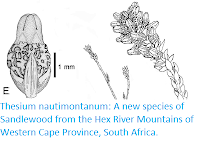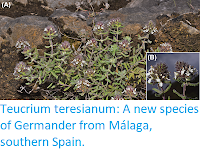Members of the genus Limonium are known as Sea Lavenders, or sometimes Marsh Rosemarys, though they are actually members of the Leadwort Family, Plumbaginaceae. They form woody herbaceous perennials or small shrubs, favouring saline or alkaline soils that most plants avoid, and are widely cultivated as ornamental garden plants. Sea Lavenders are found in Africa, Eurasia, North America and Australia, though they reach their maximum diversity around the Mediterranean Basin. A distinct cluster of species found in Southern Africa was formerly classified as a separate genus, Afrolimon, though this has not been supported by genetic evidence, and these species are now considered to be part of the genus Limonium.
In a paper published in the journal Phytotaxa on 10 May 2019, Ladislav Mucina of the Harry Butler Institute at Murdoch University, and the Department of Geography and Environmental Studies at Stellenbosch University, and Timothy Hammer of the School of Biological Sciences at the University of Western Australia, describe a new species of Sea Lavender from the Namaqualand Coast of South Africa.
The new species is named Limonium dagmarae, in honour of Dagmar Mucina, the wife of Ladislav Mucina, for her passion for the flora of Namaqualand. This species is a small shrub, forming bushes about 60 cm high, with copper-coloured woody stems and densely packed, waxy, oval leaves in an alternating arrangement. Flowers are numerous, tubular, about 5 mm in length, and produced between August and November.
Limonium dagmarae in situ, from the southernmost population of the species; overall habit (semiglobose-shaped low shrub). Ladislav Mucina in Murcina & Hammer (2019).
Limonium dagmarae is found along a strip of the Namaqualand Coast roughly 205 km long and 5-10 km wide, typically occuring in groups of several tens of individuals. Most of the land where it occurs is privately owned, and used for pasture, with much of it potentially vulnerable to development. For these reasons Murcina and Hammer recommend that the species be classified as Endangered under the terms of the International Union for the Conservation of Nature's Red List of Threatened Species.
Limonium dagmarae in situ, from the southernmost population of the species. (B) View of a branch that finished flowering not long ago (the papery calyces are still light pink and brownish ribs prominent; also showing the sparse leafing of the branch. (C) Fully developed flower, flanked by several calyces which perigone already withered and several buds prepared to flower. (D) Habitat of Limonium dagmarae; loamy-sandy strandveld scrub, with associated succulent shrubs. Ladislav Mucina in Murcina & Hammer (2019).
See also...
Follow Sciency Thoughts on Facebook.








